I’m on the advisory board of one of our local collision repair training programs. The school where the training is conducted invited a group of local outside “experts” to tour its facility and give impartial feedback on how to improve the program.
One of the suggestions was to surplus the two gas welders the program owned.
I reviewed the list of experts and found two shop owners (neither one a technician), an equipment supplier and an insurance adjuster. Not a single one had a hands-on technical background – and they were making suggestions on how to improve the program! I’m afraid that this isn’t the exception either.
I asked our instructors how they felt about the experts’ suggestions. They told me that they used the torches daily to facilitate removal of a rusty nut, release a bonded panel, warm up some heavy undercoater in order to more quickly and efficiently remove it, or cut a piece of metal to make a pull plate. In short, they were completely against “surplusing” them because of their versatility.
I was at an ASE workshop recently which, incidentally, is where the questions for the ASE tests are developed. I devised a question regarding heat shrinking body metal, which set off a half-hour debate. An “ivory tower” type from a large company told me that he got nervous every time he saw a tech approach a car with a torch in his hand.
Wake up, buddy! This has been going on for more than 100 years. It isn’t some wacky, hybridized, whatchamacallit thing with no history behind it. It’s been part of the collision repair industry from day one, so let’s not get so hasty to throw it out the window. It’s still an incredibly useful piece of equipment that can add versatility to any shop.
Can you operate a collision repair shop without an oxyacetylene welder? My guess is that you could, but you’d definitely be limiting your capabilities. Given the choice, I’d rather be more capable than less capable.
My goal here isn’t to convince you that oxyacetylene welding is a better way to weld modern vehicles or even older vehicles than MIG (Metal Inert Gas) welding. On the contrary, it isn’t, but the gas welder used as a supplement to MIG makes a dynamic duo that gives strength and depth to your capabilities.
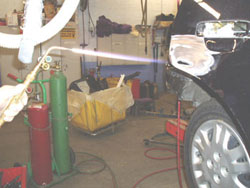
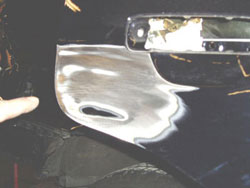 Metal Manic
Metal Manic
Any metal finisher will tell you that the use of controlled flame heat is crucial to the metal finishing process. So what is metal finishing? It’s the repair of body metal without the use of plastic filler. It’s fast and doesn’t introduce a foreign product into your repair process. Note an example of the process in 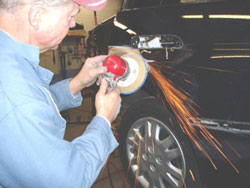
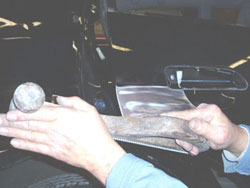 Photos 1-5 on page 40, which show how to fix a low spot in a rear door.
Photos 1-5 on page 40, which show how to fix a low spot in a rear door.
Metal Finishing Procedures:
1. Identify a shallow low spot.
2. Remove paint around the dent with 80 grit sandpaper on a grinder.
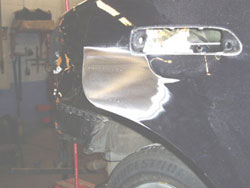 3. Install a small tip on your torch. Set your regulators at 5 to 7 lbs. for acetylene and 12 to 15 lbs. for oxygen. Ignite the torch by cracking the acetylene knob on the torch and providing a spark to the tip. Once lit, add air (oxygen) and gas (acetylene) until you have the sharpest pointed flame possible. This will be an oxidizing flame because the center cone of your flame will be highly feathered out to a sharp point and allows you more control with the heat. This is a soft flame.
3. Install a small tip on your torch. Set your regulators at 5 to 7 lbs. for acetylene and 12 to 15 lbs. for oxygen. Ignite the torch by cracking the acetylene knob on the torch and providing a spark to the tip. Once lit, add air (oxygen) and gas (acetylene) until you have the sharpest pointed flame possible. This will be an oxidizing flame because the center cone of your flame will be highly feathered out to a sharp point and allows you more control with the heat. This is a soft flame.
4. Apply a small amount of heat to the low spot. Concentrate! The moment you see the metal begin to rise, remove the heat and file with a body file. Repeat as necessary. (You shouldn’t burn paint during heating.)
5. Air cool. Grind surface with 80 grit, air cool (with blower) and re-file. Check for any lows after filing. If low spots still remain, reapply controlled heat and file. The filing actually helps lock the metal molecules in position. If you don’t file, the metal simply returns to its dented form. Regrind with 80 grit and featheredge.
Note : Be aware of a few things:
1. Watch where you point the flame when filing!
2. If the dent goes down instead of up, you’ll have to bring it out manually first.
3. This process works beautifully on hail damage.
4. Paint shouldn’t burn and metal shouldn’t turn blue during heating. Be gentle.
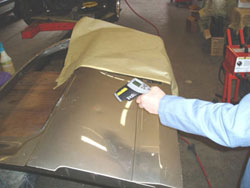
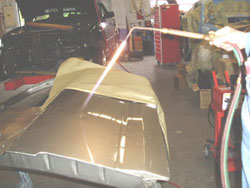 Heating Procedures:
Heating Procedures:
1. The heating of aluminum is crucial and necessary to facilitate a repair (see Photos 6-7). Aluminum is hard in its stamped shape and even harder in its dented shape.
Heat must be monitored to avoid overheating or annealing, which is the permanent softening of aluminum. This would change the engineered and designed-in hardness of the panel, which should be avoided. A non-contact thermometer on the painted area is quick and easy. An oxyacetylene torch is the quickest way to warm a panel.
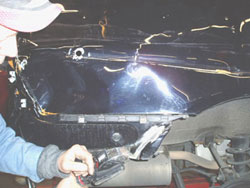
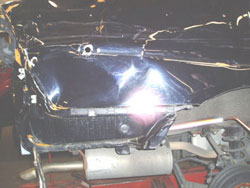 2. Warming up of undercoatings before power wire brushing (see Photos 8-9) or scraping allows a much quicker, easier and better result. Try to warm from the backside if possible. Be focused and warm coatings evenly, don’t burn. The result will be nice, clean and coating-free.
2. Warming up of undercoatings before power wire brushing (see Photos 8-9) or scraping allows a much quicker, easier and better result. Try to warm from the backside if possible. Be focused and warm coatings evenly, don’t burn. The result will be nice, clean and coating-free.
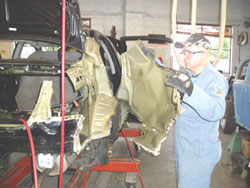
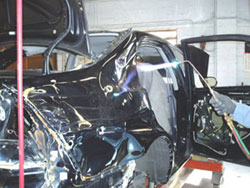 3. Quarter panels and door panels use bonding extensively. Without heat to release the bond, the job is very difficult (see Photos 10-11). Identify the location of adhesives. I like to use a larger tip or even a rose bud for releasing adhesives on the panels I’m replacing because it heats quickly and burning some paint isn’t a worry.
3. Quarter panels and door panels use bonding extensively. Without heat to release the bond, the job is very difficult (see Photos 10-11). Identify the location of adhesives. I like to use a larger tip or even a rose bud for releasing adhesives on the panels I’m replacing because it heats quickly and burning some paint isn’t a worry.
Warm it up with your torch carefully in the bond zone. Apply gentle pressure until it releases. When replacing this part, apply new adhesive to the old adhesive after final fitting of the replacement panel.
Note: Always pre-fit part before applying adhesives and be completely assured of final fit position before leaving and allowing adhesive to cure out of position.
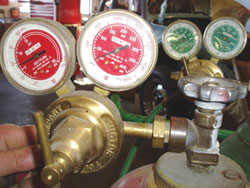
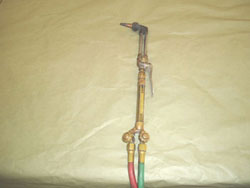 Benefits Abound
Benefits Abound
There are many devices used to cut metals: abrasive saws, reciprocating saws, air chisels and panel cutters, plasma cutters or oxyacetylene cutting torches. All of these, with the exception of the oxy torch, require electricity or compressed air. The oxy torch is self-contained and on wheels.
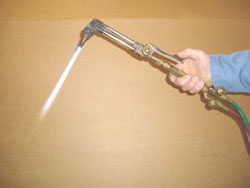 Hmm…that means I can take it to the storage lot out back and cut off that front bumper end that’s resting on the perfectly fine tire of a customer’s pickup, then drive the pickup into the shop without the use of a tow rig. Convenience in an old process!
Hmm…that means I can take it to the storage lot out back and cut off that front bumper end that’s resting on the perfectly fine tire of a customer’s pickup, then drive the pickup into the shop without the use of a tow rig. Convenience in an old process!
Cutting Procedures:
1. Attach cutting torch (see Photo 12).
2. Turn up oxygen regulator to 40 lbs. (see photo 13) and acetylene at 5 to 7 lbs.
3. With cutting knob closed and air knob on torch body fully opened, slowly crack the gas knob until you feel gas pass through cutting tip. Ignite gas with spark and add air from knob on cutting head until you have a neutral flame (see Photo 14). Depress cutting lever to release cutting air (hence 40-lb. setting).
4. Start heating at the edge of the metal, pointing the flame away from anything but the damaged part. Once the edge is cherry red, depress the cutting lever. Use gas welding goggles and gloves. Cut the part off. (See Photos 15-16).
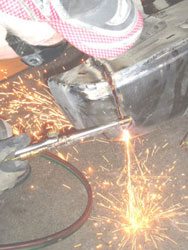
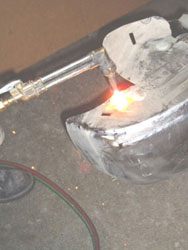 Note: Be aware of the direction of cutting sparks and prevent unnecessary damage. If it’s predictable, it’s preventable.
Note: Be aware of the direction of cutting sparks and prevent unnecessary damage. If it’s predictable, it’s preventable.


